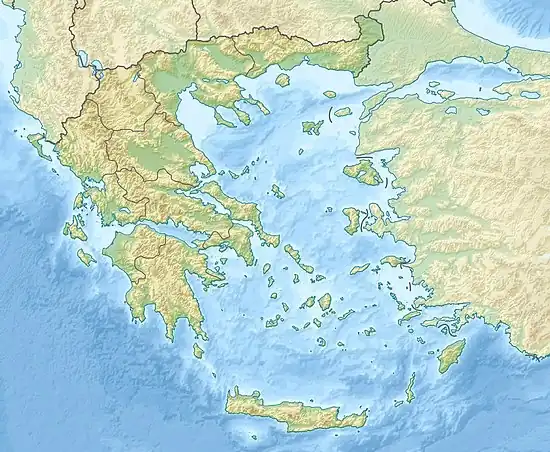Archaeological Museum of Aegina
The Archaeological Museum of Aegina (Greek: Αρχαιολογικό Μουσείο Αιγίνης) is a museum in Aegina, Greece, founded on 21 October 1828 by Ioannis Kapodistrias, the first governor of independent Greece.[1]
Αρχαιολογικό Μουσείο Αιγίνης | |
 Entrance to the building | |
 Location within Greece | |
| Established | 21 October 1828 |
|---|---|
| Location | |
| Coordinates | 37.749519°N 23.424773°E |
| Type | Archaeological museum |
| Founder | Ioannis Kapodistrias |
| Website | via odysseus.culture.gr |

Exhibits
The museum contains a variety of ancient vessels, pottery, ceramics, alabasters, statuettes, inscriptions, coins, weapons and copper vessels.[1] These objects are located in three rooms in which are all the exhibits.
One of the artifacts of the museum, an etched carnelian bead, a typical Harappan object, points to ancient trade relations with Mesopotamia and the Indus Valley civilization.[2]
The building where the museum is housed is ground floor, equilateral, stone and tiled with a patio in the center, a wooden portico surrounds the patio and one exterior of the building.[3]
Gallery
 Part of the hall of ancient sculptures and pottery.
Part of the hall of ancient sculptures and pottery. Early Bronze Age pottery, Early Helladic II, c. 2400–2300 BC.
Early Bronze Age pottery, Early Helladic II, c. 2400–2300 BC. Middle Bronze Age pithos with geometric painted decorations, c. 2000–1800 BC.
Middle Bronze Age pithos with geometric painted decorations, c. 2000–1800 BC. Middle Helladic and early Mycenaean pottery, c. 1900–1650 BC.
Middle Helladic and early Mycenaean pottery, c. 1900–1650 BC. Mycenaean figurine, c. 1700–1050 BC.
Mycenaean figurine, c. 1700–1050 BC. Protogeometric and geometric pottery, 10th–8th century BC.
Protogeometric and geometric pottery, 10th–8th century BC. Large Corinthian jug, c. 600 BC.
Large Corinthian jug, c. 600 BC.
 Funerary relief, 5th century BC.
Funerary relief, 5th century BC. Early classical sphinx, from Temple of Apollo, c. 460 BC.
Early classical sphinx, from Temple of Apollo, c. 460 BC.
References
Citations
- www.aegina.com
- Art of the First Cities: The Third Millennium B.C. from the Mediterranean to the Indus. Metropolitan Museum of Art. 2003. p. 261, Object 266 a and b. ISBN 978-1-58839-043-1.
- Archaeological Museum of Kolona: Description
Sources
- Papastavrou, Eleni (2012). "Archaeological Museum of Kolona: Description". Greek Ministry of Culture and Sports. Retrieved 29 December 2020 – via odysseus.culture.gr.